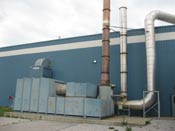Case study: Reconfiguration Saves Energy for Wheel Maker
CMWA uses existing RTOs more efficiently
- By Greg Thompson
- Apr 03, 2009
 Central Motor Wheel of America, Inc. (CMWA) makes steel and aluminum wheels for the automotive industry. The company is a joint venture of Central Motor Wheel of Japan, Ltd. and Toyota Tsusho of America, located on 55.4 acres in Paris, Ky. During a companywide initiative to save energy, the aluminum division asked the Environmental and Energy Systems (EES) Group of Dürr Systems Inc. to help the plant determine how to reduce its fuel consumption.
Central Motor Wheel of America, Inc. (CMWA) makes steel and aluminum wheels for the automotive industry. The company is a joint venture of Central Motor Wheel of Japan, Ltd. and Toyota Tsusho of America, located on 55.4 acres in Paris, Ky. During a companywide initiative to save energy, the aluminum division asked the Environmental and Energy Systems (EES) Group of Dürr Systems Inc. to help the plant determine how to reduce its fuel consumption.
In its initial evaluation, Dürr targeted the two paint lines and their respective emission control devices. Each line consists of primer and topcoat booths that recirculate a significant amount of air back to the spray booth while a portion of the air exhausts to a thermal oxidizer emission control system. A fresh air source replaces the exhausted air so that the amount of air in the booths remains constant. Each line has primer and topcoat ovens that also exhaust to the oxidizers.
One of the paint lines was equipped with a 15,000 standard cubic feet per minute (Scfm), high efficiency, Dürr Ecopure® RL15 regenerative thermal oxidizer with an energy recovery rating of 95 percent and an average temperature rise across the unit of 100° Fahrenheit. The other line treated emissions with a 13,000 Scfm recuperative thermal oxidizer with an energy recovery rating of about 55 percent and a temperature rise of about 580° F. Because both oxidizers treated relatively the same air volume and emission concentration -- 11,675 Scfm and 21 pounds per hour on average -- the recuperative oxidizer became an area of distinct energy-saving opportunity.
"The recuperative oxidizer probably offered a lower capital cost and improved the bottom line of the initial paint line package investment," said Karl Walby of the Dürr EES aftermarket sales team. "However, the inefficiency of the recuperative oxidizer resulted in long-term fuel consumption approaching $500,000 per year based upon today’s natural gas prices." The comparative fuel consumption costs of the other paint line were closer to $65,000 per year.
Because both oxidizers were using upwards of 84 percent of their capacity, the options included replacing the recuperative unit with a new high-efficiency regenerative thermal oxidizer, recovering recuperative oxidizer exhaust heat to supplement the paint process ovens, or developing some other creative solution.
After completing a cost-benefit analysis of the first two options, the company found the most beneficial solution existed at the end of the steel division's paint line, about 200 yards from the aluminum division. The steel division already was equipped with a 40,000 Scfm, high efficiency, Ecopure® RL40 regenerative thermal oxidizer, that was used to treat emissions from a similar paint process. That RTO was only being used at about 35 percent of its capacity. The steel plant originally expected the unit to be used at a greater capacity, but various strategic changes to process formulations, environmental, and air balance initiatives kept the emission control volume of the steel line comparable to that of the aluminum lines.
The resulting strategy was to optimize the overall emission control scheme for both divisions. The project was one of both reconditioning and relocation. The RTO from the steel line was relocated to treat the combined emissions from both aluminum paint lines. The recuperative oxidizer was removed from service. The aluminum division RTO was relocated to the steel paint line, where it could provide sufficient capacity.
The existing equipment foundations had both been reinforced to the extent that no changes were required at either site to accommodate the relocations. Both units were reconditioned according to company preventative maintenance recommendations while the units were dismantled for relocation.
 Once the RTOs were relocated and the recuperative oxidizer was removed from service, the duct work from the corresponding paint line was rerouted a nominal 180-feet to the newly relocated RTO along with the first paint line. Even with the combined emissions from both of the aluminum lines, the plant has 40 percent more capacity available in the unit if future sources require controls.
Once the RTOs were relocated and the recuperative oxidizer was removed from service, the duct work from the corresponding paint line was rerouted a nominal 180-feet to the newly relocated RTO along with the first paint line. Even with the combined emissions from both of the aluminum lines, the plant has 40 percent more capacity available in the unit if future sources require controls.
The project was executed in a six-week schedule from order receipt to completion. During the third week of the project, CMWA process engineer and project leader Brent Hurley said, "I think the project is going exceedingly well. I could not be happier with Dürr’s site supervisors and subcontractors. They know exactly what they are doing and they are able to keep me confident in the success of the project."
The changes achieved an 80-percent reduction in fuel consumption with a natural gas reduction of 7.25 million Btu’s per hour and a projected $427,000 per year savings based on current fuel costs and production hours.
About the Author
Greg Thompson is a marketing associate at Dürr Systems, Inc. in the Environmental and Energy Systems Group.